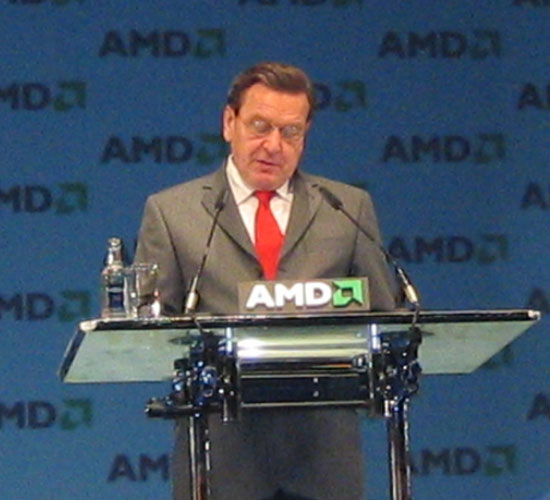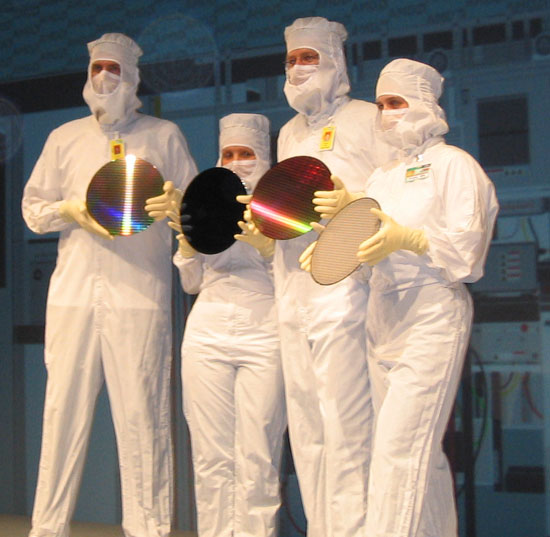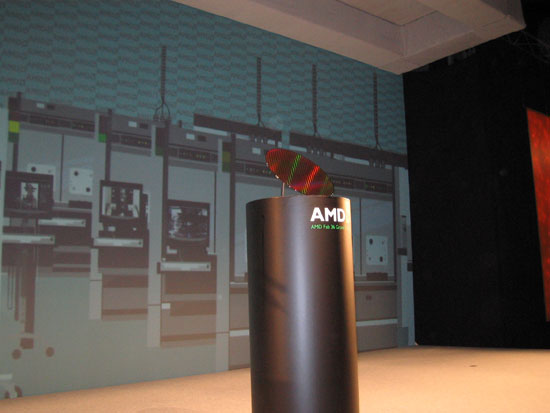AMD's Fab 36 Grand Opening - 90nm and 300mm in Germany
by Anand Lal Shimpi on October 14, 2005 7:50 AM EST- Posted in
- CPUs
AMD Draws a Crowd: German Chancellor Schröder Arrives
After the initial press conference we took a short bus ride to an outside tent where both Dr. Deppe and Dr. Ruiz gave a few words about Dresden and Fab 36, before handing the mic off to German Chancellor Gerhard Schröder.
One point to note was the constant mentioning of "fair competition" in all of Dr. Ruiz speeches, obviously referring to AMD's recent lawsuit against Intel. Dr. Ruiz also mentioned AMD's 50-by-15 goal; that by 2015, 50% of the world will be "connected", partially in thanks to an increase in production of AMD's products. Intel has also outlined their plans for 2015, which we've covered in the past.

German Chancellor Gerhard Schröder
Chancellor Schröder also made it a point to mention the importance of such a large investment in Dresden, being a part of former East Germany, while stressing that the incoming German government should make it a point to encourage similar investments in the future.
Chancellor Schröder also briefly touched on the topic of fair competition and how Germany's cooperation with AMD has been in the spirit of fair competition, also clearly in reference to AMD's recent lawsuit.

Governer of Saxony, Professor Dr. Georg Milbradt
Dresden is located in the German state of Saxony, and next up was the Governer of the State of Saxony, Professor Dr. Georg Milbradt. Professor Milbradt spoke of the history of Saxony from its humble beginnings to being a center for semiconductor manufacturing thanks to companies like AMD and Siemens.
Professor Milbradt's speech also took a political tone, as he stressed the importance of the new federal government to do even more to encourage investments such as AMD's in Dresden. He stressed that the investments are necessary in order to make Saxony and Dresden competitive in the EU and in the world.
Both Milbradt and Schröder hinted that AMD should definitely consider Dresden for their next fab plant, which Dr. Ruiz mentioned could potentially begin construction as early as 2008.

More 300mm wafers, we counted at least 5 today, that should be enough for at least a few Athlon 64 X2s.
The speeches were concluded with a ceremonial "raising of the wafer" as a 300mm wafer rose from the stage and was presented to Dresden, the state of Saxony and Dresden.

The events at Fab 36 in Dresden are just beginning, we're about to head to a Q&A session followed by some technical tracks and tours of the new plant.
AMD is hopefully going to present us with their future plans later today, which we've been looking forward to ever since Intel's IDF announcements. We'll see if AMD can deliver a more interesting look at their future than the ambiguity that we've been given in the past; stay tuned.










70 Comments
View All Comments
eljefe2 - Friday, October 14, 2005 - link
I rather it be in a place where they pay real wages. at least it then stops some trends in big business.And yes prior to amd k6-II, amd made some bad things. Then the k6-III, the athlon, xp, a64, dual core, all trumped intel crap. it took me a many years before I realized this.
I think that has been a while now. xp onward has obviously beat out intel for home use, and now, in every use (besides vector graphics, and of course, we all are manipulating vector graphic intensive programs as we type.... yea....)
the only saving thing is pentium M for intel. and they have refused to release that as a desktop chip for many years. how crappy can you get. I just want to know WHY people are so supportive of a poorly serving the public company which HAD the means to provide much better products than AMD yet refused to.
eljefe2 - Friday, October 14, 2005 - link
.... i meant i rather it be in a place that gives real wages, either US or in Europe, other than some random asian country.nserra - Friday, October 14, 2005 - link
Remember that AMD processors are not made of the same "compounds" of Intel processors.Maybe AMD could also launch a 65nm based processor based on "compounds" of Intel processors.
As
Intel could "never" launch NOW a 65nm based processor using AMD "compounds".
eljefe2 - Friday, October 14, 2005 - link
15-18% difference in wattage pull at max draw and no difference in performance is what intel got out of 65nm process.THAT's IT.
at that level, amd still blows it away at 90 nm. amd hasnt moved to 65nm because it is not a crappy chip company. it always does better than the other companies at the larger nm size. Why should it have to change? when it does, it will be even better, which will be fantastic, not just an inflated figure. Idle wattages are most important and so intel hasnt anything to say about that at all still with their 65nm process. (chips dont go full max all that often in the real world, and when they do, the 65nm intels are still power hogs.)
Shintai - Saturday, October 15, 2005 - link
You mean 65nm suck like:Dothan -> Yonah: 1 extra core, better FPU, better SSE, higher FSB and better cache for 4W extra (31W total) aswell as cheaper to make than a single Dothan? (A dual Dothan with 667FSB would use about 60-65W)
Prescott -> Cedar Mill(?): 15/25W drop in powerusage and 25-30% cheaper to manuafacture?
Smithfield -> "Whatever the dualcore is named": Same as above, just with a higher wattage drop.
Ye that kinda seem to suck really bad...
If you think AMD or Intel will boost speedgrades alot with 65nm you gonna be so wrong. It will be more cores, cheaper cores and less power as primary focus.
65nm is just giving Intel a better price/volume advantage the next 12 months.
Spoonbender - Friday, October 14, 2005 - link
haha, that's funny. We need more fanboys who don't know what they're talking about.First, AMD has made some lousy processors in the past, far crappier than anything Intel could ever dream of.
Second, the main reason for advancing to 65nm is not performance, it's cost.
AMD could certainly benefit from doubling the number of dies per wafer. Even if they OMFGR0XXORZ Intel's chips performance-wise.
Griswold - Friday, October 14, 2005 - link
Spoken like a true fanboi.
trooper11 - Friday, October 14, 2005 - link
but the point is it wont kill amd if they dont have 65nm parts out to market will the 2nd half of 06Spoonbender - Friday, October 14, 2005 - link
Well, it will prevent them from lowering prices as much as Intel can do without actually losing money. Of course, that probably won't *kill* them, but it can hurt them. They only recently got into the habit of making a profit at all. Having their production costs around twice Intel's level is bad. (Although admittedly, I believe the P4 dies are way bigger than A64's, so they do partially compensate there)coldpower27 - Friday, October 14, 2005 - link
Don't use NetBurst as a yardstick for the 65nm process, think of it this way, if the 65nm process can reduce heat disppation for NetBurst technology, think of what it could for Pentium M based technology or Merom/Conroe.Remember heat disppation was reduced on the Banias to Dothan Pentium M transition and that core still uses the same 90nm process as Prescott did.